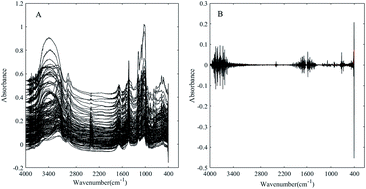Fourier transform infrared spectroscopy coupled with chemometrics for determining the geographical origin of kudzu root and the detection and quantification of adulterants in kudzu root†
Abstract
In this study, Fourier transform infrared spectroscopy and chemometric analysis were carried out to determine the geographical origin of kudzu root and detect and quantify adulterants in kudzu root. A total of 150 natural kudzu root samples from five different geographical origins and 750 adulterated kudzu root samples with different doping levels ranging from 2% to 50% (w/w) were investigated via FTIR and then subjected to pattern recognition processes. Regardless of whether the kudzu root samples were pure or adulterated, the principal component analysis (PCA) showed clustering trends for both types of sample. Compared with PCA, better classification results were obtained with partial least-squares discriminant analysis (PLS-DA) using the second derivative to preprocess the infrared spectral data. The analysis of authentic kudzu root samples with different geographical origins achieved a recognition rate as high as 99% for training sets and a 98% recognition rate for predicted sets. For the adulterated kudzu root samples, PLS-DA obtained a 100% recognition rate for training sets and a 97% recognition rate for predicted sets. The high recognition and satisfactory predictive capability of the PLS-DA model proved that the proposed method was a non-targeted, powerful, and practical tool, which was suitable for tracing the geographic origin of kudzu root and quantifying adulterants in kudzu root products.



 Please wait while we load your content...
Please wait while we load your content...